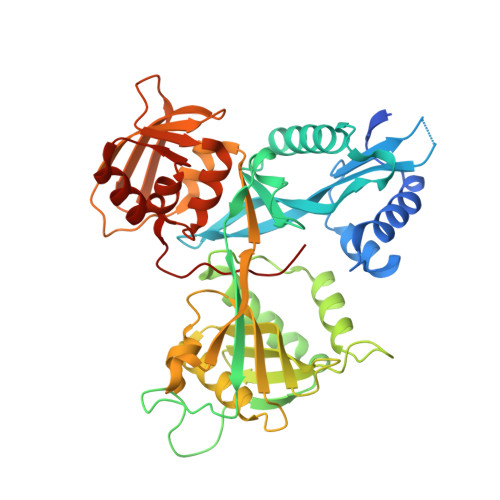Combating Enhanced Intracellular Survival (Eis)-Mediated Kanamycin Resistance of Mycobacterium tuberculosis by Novel Pyrrolo[1,5-a]pyrazine-Based Eis Inhibitors.
Garzan, A., Willby, M.J., Ngo, H.X., Gajadeera, C.S., Green, K.D., Holbrook, S.Y., Hou, C., Posey, J.E., Tsodikov, O.V., Garneau-Tsodikova, S.(2017) ACS Infect Dis 3: 302-309
- PubMed: 28192916
- DOI: https://doi.org/10.1021/acsinfecdis.6b00193
- Primary Citation of Related Structures:
5TVJ - PubMed Abstract:
Tuberculosis (TB) remains one of the leading causes of mortality worldwide. Hence, the identification of highly effective antitubercular drugs with novel modes of action is crucial. In this paper, we report the discovery and development of pyrrolo[1,5-a]pyrazine-based analogues as highly potent inhibitors of the Mycobacterium tuberculosis (Mtb) acetyltransferase enhanced intracellular survival (Eis), whose up-regulation causes clinically observed resistance to the aminoglycoside (AG) antibiotic kanamycin A (KAN). We performed a structure-activity relationship (SAR) study to optimize these compounds as potent Eis inhibitors both against purified enzyme and in mycobacterial cells. A crystal structure of Eis in complex with one of the most potent inhibitors reveals that the compound is bound to Eis in the AG binding pocket, serving as the structural basis for the SAR. These Eis inhibitors have no observed cytotoxicity to mammalian cells and are promising leads for the development of innovative AG adjuvant therapies against drug-resistant TB.
Organizational Affiliation:
Department of Pharmaceutical Sciences, College of Pharmacy, University of Kentucky , 789 South Limestone Street, Lexington, Kentucky 40536-0596, United States.


















